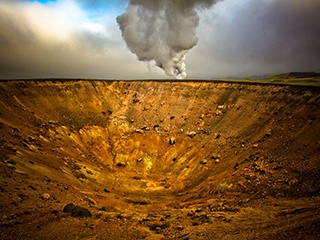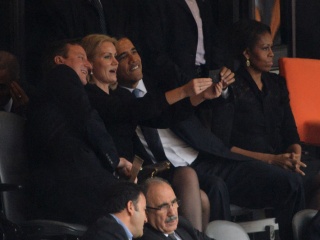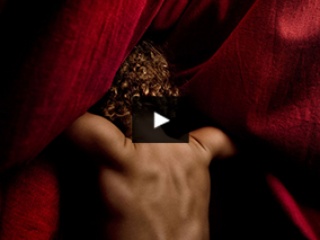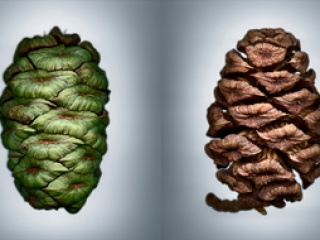ZoneZero
Interview with Virgil Widrich about his work. February 2015
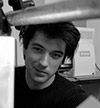 Virgil Widrich (Salzburg, 1967). Lives in Vienna. He works on numerous multimedia and film productions. His first feature film is Heller als der Mond (Brighter than the Moon). His short film Copy Shop won 35 international awards and was nominated for the Oscar. Fast Film premiered in Cannes 2003 and won 36 awards until today. At the moment Widrich is working on a new feature film The Night of a Thousand Hours.
Virgil Widrich (Salzburg, 1967). Lives in Vienna. He works on numerous multimedia and film productions. His first feature film is Heller als der Mond (Brighter than the Moon). His short film Copy Shop won 35 international awards and was nominated for the Oscar. Fast Film premiered in Cannes 2003 and won 36 awards until today. At the moment Widrich is working on a new feature film The Night of a Thousand Hours.Interview with Virgil Widrich about his work. February 2015
 Virgil Widrich (Salzburg, 1967). Lives in Vienna. He works on numerous multimedia and film productions. His first feature film is Heller als der Mond (Brighter than the Moon). His short film Copy Shop won 35 international awards and was nominated for the Oscar. Fast Film premiered in Cannes 2003 and won 36 awards until today. At the moment Widrich is working on a new feature film The Night of a Thousand Hours.
Virgil Widrich (Salzburg, 1967). Lives in Vienna. He works on numerous multimedia and film productions. His first feature film is Heller als der Mond (Brighter than the Moon). His short film Copy Shop won 35 international awards and was nominated for the Oscar. Fast Film premiered in Cannes 2003 and won 36 awards until today. At the moment Widrich is working on a new feature film The Night of a Thousand Hours.ZoneZero

Considered a visual artist, interactive narrator and Internet anthropologist, Harris is interested in the fragments and feelings of intimate stories, and our need to express ourselves. He converses with the viewer through images and technology, interconnected them to his own artistic universe.
In his essay Navigating Stuckness, which consists of texts and illustrations, Harris shares an autobiographical journey, describing the successive stages of his development as a creator and how he has forced himself to surpass and rediscover himself. ZoneZero has chosen two projects from these various stages, to present a sample of the enormous variety and diversity of his platforms of expression, as a glimpse of his versatile artwork.
The first is Today, photographs documenting the 440 days that followed Harris’s 30th birthday, defining a self-portrait of his everyday life and transforming this process into a ritual. In the second, Balloons of Buthan, he presents portraits of happiness in the last Himalayan kingdom, Bhutan. He uses photographs and audio testimonials to address universal concerns, and records action through an interactive platform in which we can approach each of the 117 persons he met.
These are only two examples, showing two principal lines of Harris’s artistic activity. One of these is realizing that in order to approach other people and depend on them, we must pause to know and speak about ourselves. The other line is interpreting how we can converge with technology as the best means of telling stories, thus creating platforms that give order to human chaos in our globalized, Internet-centered world.
Harris is perhaps one of the most sensitive artists present online, whose projects can inspire us to continue our own pursuit of visual communication. The ZoneZero team therefore presents an interview with him, to provide an insight into the processes involved in his work.
 Jonathan Harris (USA, 1979). Lives and works in New York, though he undertakes some of his projects in others parts of the world. Balloons of Buthan, for example, was produced in Buthan, Himalaya. An artist and computer scientist, his work explores the relationship between humans and technology. He graduated in Computer Science and Photography from Princeton University. His artwork has been exhibited throughout the world and has earned several prizes and awards. It can be viewed at: Number27
Jonathan Harris (USA, 1979). Lives and works in New York, though he undertakes some of his projects in others parts of the world. Balloons of Buthan, for example, was produced in Buthan, Himalaya. An artist and computer scientist, his work explores the relationship between humans and technology. He graduated in Computer Science and Photography from Princeton University. His artwork has been exhibited throughout the world and has earned several prizes and awards. It can be viewed at: Number27Regarding the development of your projects, could you tell us what's the place of the concept and what role does your selected media play?
For me, projects tend to start with a concept — usually something simple and communicable in a single sentence (e.g. “A search engine for feelings” (We Feel Fine), “A public library of human experience” (Cowbird), “An expression of single moments in time” (10x10). From there, I spend a lot of time developing the idea on paper (in my sketchbook). This process is iterative, and can take a long time. I’ll usually try a lot of different angles and approaches, and many of them won’t feel right, so I’ll keep trying different things, all the while keeping in mind that single-sentence description, which is like the soul of the idea, and that soul should never change. At some point, I’ll decide on an angle (e.g. search for the phrase “I feel”; constrain stories to text and a single image; scrape news websites every hour for 100 words and pictures; etc.), and will start collecting data. Then, there's the process of developing a relationship with that data, which is almost like learning the ways of a lover — to try to understand its secrets (i.e. what about it is beautiful and interesting). Once you learn its secrets, then you can design interfaces that reveal those secrets to others. That is what makes something feel poetic, and what makes it come alive.
On your most recent work, what are the topics or concerns that move you to start and develop a new project?
Currently, I’m interested in the evolution of the human species into a single meta-organism, in which we all take part, like cells in a body. I’m interested in the nature of that meta-organism — its emotions, its thoughts, its desires, its choices.
With the constant changes on technology and projects that rely so much on it, do you worry about obsolescence? How do you deal with that risk?
Working with technology, obsolescence is unavoidable. Already, some of my earlier projects are difficult or impossible to see — most browsers no longer support Java applets by default, so to view We Feel Fine, visitors must download and install a plugin; the company whose news API powered Universe was acquired and no longer exists, so that project is sadly offline. Nowadays, I try to use open source technologies (HTML5, Javascript, WebGL, etc.), which are less likely to become obsolete than proprietary technologies like Java and Flash.
On an aesthetic level, obsolescence is also a danger, but this kind of obsolescence is related to the homogenizing effect of popular tools. For instance, when many people use a tool like Adobe Illustrator, Adobe Flash, or even a service like Instagram, the shortcuts enabled by the tool will, over time, have a homogenizing effect on the projects that people use the tool to create. Because of this, many digital projects quickly look dated — they are timely, but not timeless. To avoid this, I try to design all my interfaces from scratch, not relying on shortcuts enabled by tools, but generated programmatically by code I write myself. So, for example, the typography in The Whale Hunt is custom-designed to be bisected by whaling harpoons. In Universe, all the typography is formed by star constellations. When you write stuff from scratch (using open source tools), you have a better chance at avoiding obsolescence.
You can learn more about Harris's concerns and obsessions by visiting number27.org

Considered a visual artist, interactive narrator and Internet anthropologist, Harris is interested in the fragments and feelings of intimate stories, and our need to express ourselves. He converses with the viewer through images and technology, interconnected them to his own artistic universe.
In his essay Navigating Stuckness, which consists of texts and illustrations, Harris shares an autobiographical journey, describing the successive stages of his development as a creator and how he has forced himself to surpass and rediscover himself. ZoneZero has chosen two projects from these various stages, to present a sample of the enormous variety and diversity of his platforms of expression, as a glimpse of his versatile artwork.
The first is Today, photographs documenting the 440 days that followed Harris’s 30th birthday, defining a self-portrait of his everyday life and transforming this process into a ritual. In the second, Balloons of Buthan, he presents portraits of happiness in the last Himalayan kingdom, Bhutan. He uses photographs and audio testimonials to address universal concerns, and records action through an interactive platform in which we can approach each of the 117 persons he met.
These are only two examples, showing two principal lines of Harris’s artistic activity. One of these is realizing that in order to approach other people and depend on them, we must pause to know and speak about ourselves. The other line is interpreting how we can converge with technology as the best means of telling stories, thus creating platforms that give order to human chaos in our globalized, Internet-centered world.
Harris is perhaps one of the most sensitive artists present online, whose projects can inspire us to continue our own pursuit of visual communication. The ZoneZero team therefore presents an interview with him, to provide an insight into the processes involved in his work.
 Jonathan Harris (USA, 1979). Lives and works in New York, though he undertakes some of his projects in others parts of the world. Balloons of Buthan, for example, was produced in Buthan, Himalaya. An artist and computer scientist, his work explores the relationship between humans and technology. He graduated in Computer Science and Photography from Princeton University. His artwork has been exhibited throughout the world and has earned several prizes and awards. It can be viewed at: Number27
Jonathan Harris (USA, 1979). Lives and works in New York, though he undertakes some of his projects in others parts of the world. Balloons of Buthan, for example, was produced in Buthan, Himalaya. An artist and computer scientist, his work explores the relationship between humans and technology. He graduated in Computer Science and Photography from Princeton University. His artwork has been exhibited throughout the world and has earned several prizes and awards. It can be viewed at: Number27Regarding the development of your projects, could you tell us what's the place of the concept and what role does your selected media play?
For me, projects tend to start with a concept — usually something simple and communicable in a single sentence (e.g. “A search engine for feelings” (We Feel Fine), “A public library of human experience” (Cowbird), “An expression of single moments in time” (10x10). From there, I spend a lot of time developing the idea on paper (in my sketchbook). This process is iterative, and can take a long time. I’ll usually try a lot of different angles and approaches, and many of them won’t feel right, so I’ll keep trying different things, all the while keeping in mind that single-sentence description, which is like the soul of the idea, and that soul should never change. At some point, I’ll decide on an angle (e.g. search for the phrase “I feel”; constrain stories to text and a single image; scrape news websites every hour for 100 words and pictures; etc.), and will start collecting data. Then, there's the process of developing a relationship with that data, which is almost like learning the ways of a lover — to try to understand its secrets (i.e. what about it is beautiful and interesting). Once you learn its secrets, then you can design interfaces that reveal those secrets to others. That is what makes something feel poetic, and what makes it come alive.
On your most recent work, what are the topics or concerns that move you to start and develop a new project?
Currently, I’m interested in the evolution of the human species into a single meta-organism, in which we all take part, like cells in a body. I’m interested in the nature of that meta-organism — its emotions, its thoughts, its desires, its choices.
With the constant changes on technology and projects that rely so much on it, do you worry about obsolescence? How do you deal with that risk?
Working with technology, obsolescence is unavoidable. Already, some of my earlier projects are difficult or impossible to see — most browsers no longer support Java applets by default, so to view We Feel Fine, visitors must download and install a plugin; the company whose news API powered Universe was acquired and no longer exists, so that project is sadly offline. Nowadays, I try to use open source technologies (HTML5, Javascript, WebGL, etc.), which are less likely to become obsolete than proprietary technologies like Java and Flash.
On an aesthetic level, obsolescence is also a danger, but this kind of obsolescence is related to the homogenizing effect of popular tools. For instance, when many people use a tool like Adobe Illustrator, Adobe Flash, or even a service like Instagram, the shortcuts enabled by the tool will, over time, have a homogenizing effect on the projects that people use the tool to create. Because of this, many digital projects quickly look dated — they are timely, but not timeless. To avoid this, I try to design all my interfaces from scratch, not relying on shortcuts enabled by tools, but generated programmatically by code I write myself. So, for example, the typography in The Whale Hunt is custom-designed to be bisected by whaling harpoons. In Universe, all the typography is formed by star constellations. When you write stuff from scratch (using open source tools), you have a better chance at avoiding obsolescence.
You can learn more about Harris's concerns and obsessions by visiting number27.org
André Gunthert
André Gunthert, "Conversational image: new uses of digital photography.", Etudes photographiques, n° 31, printemps 2014.
The connected photography can't exist without a recipient. Beyond a first-degree utility, the communicative systems also give images the function of engaging in a conversation or a dialogical unity. This way they acquire a second-degree utility as expressive forms. In private exchanges, the protection of the messages and the familiarity of the participants encourages implicit contents, contextual games, or transgression24. In social networks, the public visibility enables collective practices: a participative interpretation through a series of commentaries generated by an iconic source, or a choral construction, by taking and repeating a motive transformed in a meme25, that shows the social productivity of visual forms (see fig. 6).
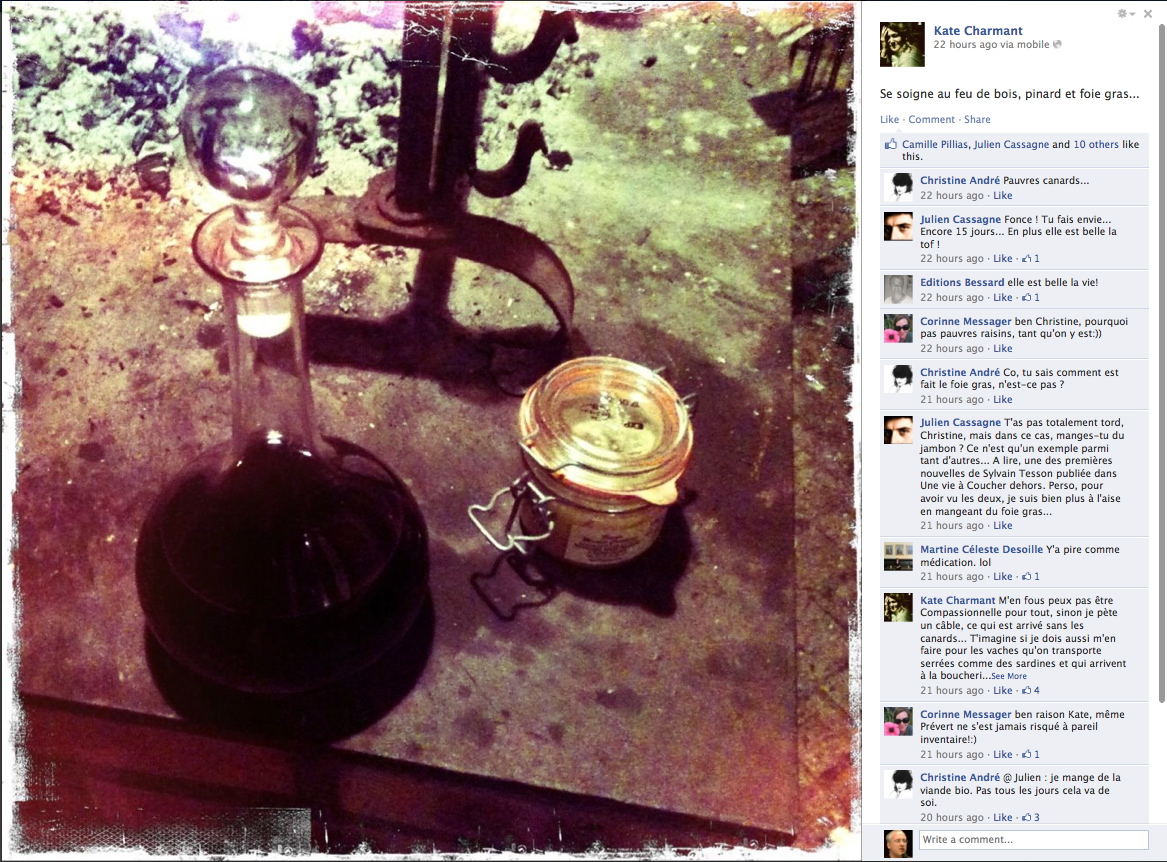
Fig. 6. Picture published in Facebook and its accompanying conversation, February 2012 (Hipstamatic, courtesy of Catherine Harmant).
As a sign of its success, we see a tendency to an autonomy of the visual conversation, through tools of collection and rebroadcast of images, such as Tumblr (2007) or Pinterest (2010), where retaking and circulating the content are the main resources of validation. A platform dedicated to the connected image, such as Instagram (2010), allows helping in the creation of collaborative answers to a common event, a meteorological phenomenon or a cultural occasion, welcomed by a photographic production whose display takes the aspect of a collective game (see fig 7).
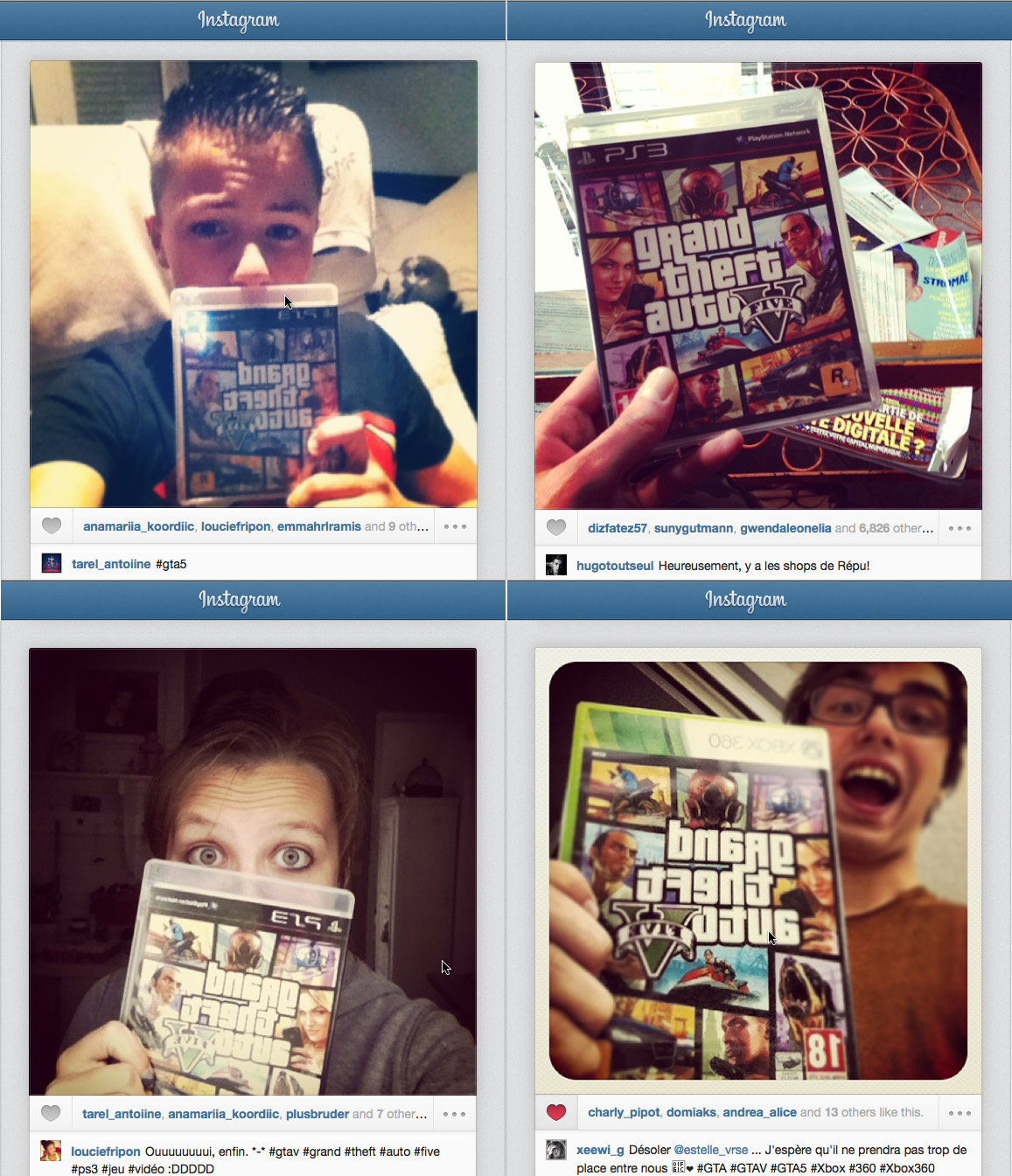
Fig. 7. Collection of selfies published in Instagram on the release date of the video game Grand Theft Auto 5, September 2013 (priv. coll.).
Conversely, integrating images in the conversation makes them benefit from the validation systems that reward participating in social networks. The exposition and public appreciation of self-produced photography grant it a critical, aesthetic or social legitimacy. They also favor the presence of an autonomous interpretation exercise, that seems necessary to reduce the ambiguity of the images26.
By sharing broadly the new visual practices, the big social networks also give them an unprecedented visibility and contribute to their viral propagation. A satirical video published in December 2012 at the College Humor site redirects a song by Nickelback to make fun of the trends in connected photography27. Pictures of meals, feet, cats, airplane wings, filters, selfies, etc.: the clip draws up a long list of themes repeated on the timelines of Facebook and Twitter. This excellent parody shows that placing these visual forms together is beautiful and correctly identified as numerous autonomous patterns.
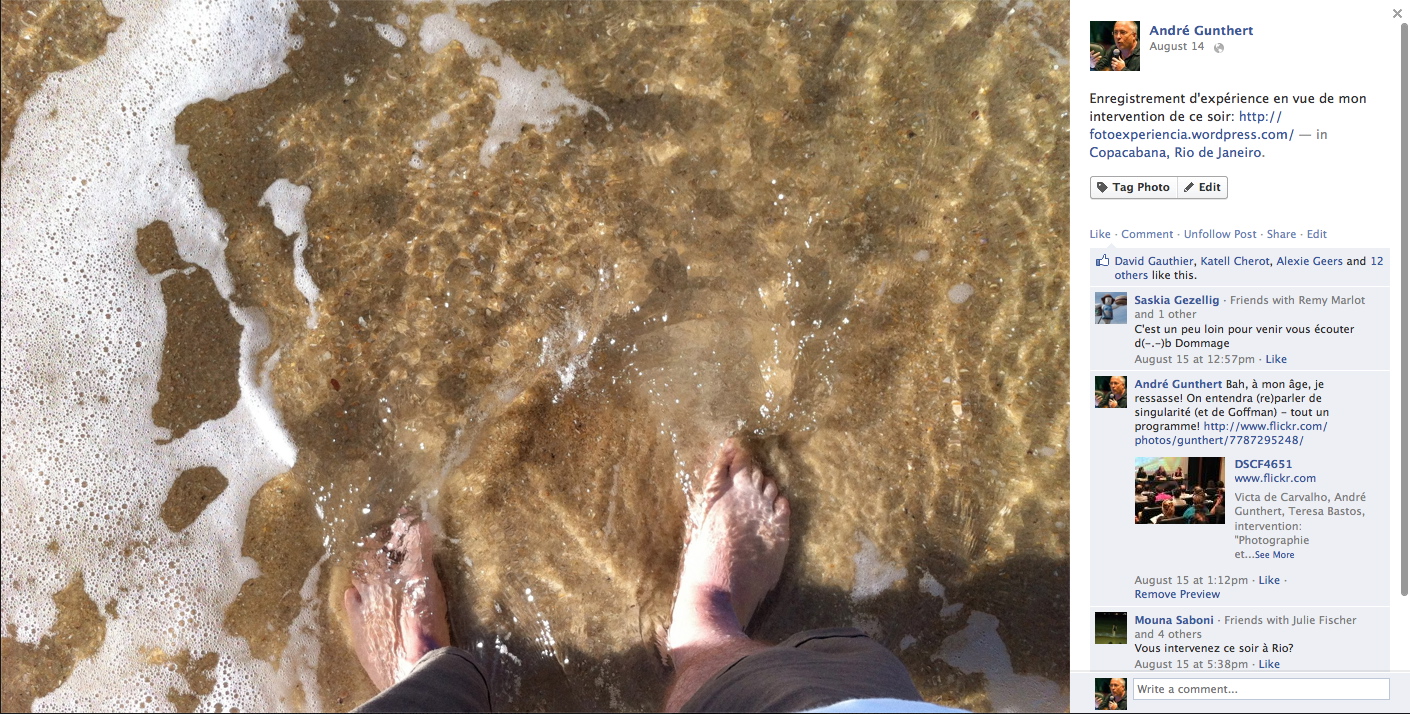
Fig. 8. Contextual self-photograph of a pair of feet published on Facebook, Rio de Janeiro, August 2012 (priv. coll.).
By examining the characteristics of private photographies from the early 20th century, Marin Dacos noticed that a large part of album photos reproduced the models of studio photography or publicity published on the papers28. By granting a group of visual practices a certificate of recognition, the video of College Humor suggests that from now on we help in a reversal phenomenon. As with memes or recommendations, the private iconography benefits from the transition that sees social networks take the place of traditional media in terms of cultural developers. Through them, the vernacular productions achieve a rank of identifiable and reproducible models.
This new visibility manifests particularly through negative reactions. This way, in 2013 we were able to see "selfie" being selected as word of the year by the editors of the Oxford Dictionary due to a share of media commentaries that denounced that the Web was saturated with this narcissistic exercise of connected self-portraits29. By criticizing an excessive presence, this reception is witnessing an standard that the genre is in the process of achieving.
When Michel de Certeau was trying to get close to the "ordinary culture", he expressed his discomfort at facing the "almost invisibility" of practices "that were hardly signaled by their own products30". On the contrary, the visibility that the main social networks give the individual expression reverse the dynamic of the production of the standard. In the past, the popular classes copied whatever the stars did. From this point forward, celebrities and the big names of this world are the ones who reproduce the models issued by the general public by conforming themselves to the rules of the selfie.
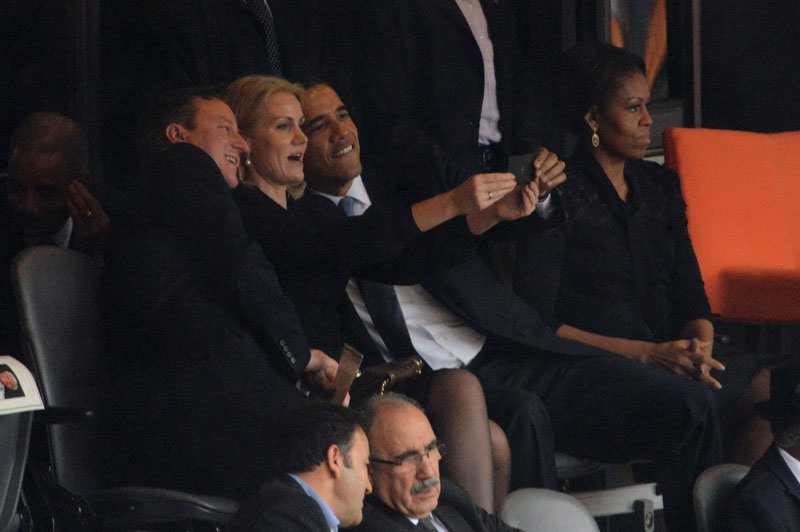
Fig. 9. Roberto Schmidt, photograph of a selfie with a smartphone by Danish Prime Minister Helle Thorning--‐Schmidt next to Barack Obama and David Cameron during the Nelson Mandela memorial service, December 11th, 2013 (AFP).
We can regret this development of a "barbaric taste" —to quote Kant's expression retaken by Bourdieu31— by social networks, the intermediaries of the ordinary culture. But isn't bringing good and bad taste into opposition the wrong way of address the problem? While the visual or musical practices encourage an unexpected approach inspired on art history, that places first the creativity of the authors and supposes a self-sufficiency for the expressive motivation, the test of language forms proposes a neutral description of the process. But, unlike the creation, or even the expression, the conversation is an autonomous domain with a communicative and social utility32. In this context, the new visual practices shouldn't be analyzed only from an aesthetic point of view.
The victory of use over content is particularly obvious with Snapchat (2011), a mobile application of visual messaging that offers the possibility of deleting the picture a few seconds after consulting it.
This feature of protected conversations through the fugacity of an iconic message has become a success for this medium with the young population, who uses it at a rhythm similar to SMS. By programming the disappearance of the image, Snapchat adds a playful dimension, as well as a supplementary freedom for the user, promoting an informal or relaxed use. The application clearly illustrates the desertion of the territory of labor and elaboration in favor of a conversation in real time. Already broadly detectable by most social networks, this shift suggests the description of ordinary practices of the image as a new language.
As with the arrival of the cinema or the television, the arrival of the conversational image transforms deeply our visual practices. Photography used to be an art and a medium. We are living the moment when it is accessing the universality of a language. Integrated by multipurpose tools for connected systems, the visual forms have begun to engage greatly in both private and public conversations. Whatever individuals can do for their production and interpretation contributes to a fast evolution of formats and uses. The visibility conferred by social networks speeds their diffusion and gives birth to self-produced standards. The appropriation of the visual language helps reinvent everyday life. Moreover, the extension of the utility of images states specific problems to be analyzed. If the semiotics of visual forms had until now leaned on a narrow register of assumed contexts, identifiable by a unique formal test, the variety of these new applications is imposing a change towards an ethnography of uses.
24 Tim Kindberg, Mirjana Spasojevic, Rowanne Fleck, Abigail Sellen, "I Saw This and Thought of You. Some Social Uses of Camera Phones", Extended Abstracts of the Conference on Human Factors in Computing Systems (CHI 2005), 2005, ACM Press, p. 1545-1548 ; Gaby David, "The Intimacy of Strong Ties in Mobile Visual Communication", Culture Visuelle, April 22th, 2013 (http://culturevisuelle.org/corazonada/2013/04/22/the-intimacy-of-strong-ties-in-mobile visualcommunication/).
25 A meme is a repetitive pattern whose viral diffusion takes the form of an adaptable game based on decontextualization (André Gunthert, “La culture du partage ou la revanche des foules”, in Hervé Le Crosnier (dir.), Culturenum. Jeunesse, culture et éducation dans la vague numérique, Caen, C & F Editions, 2013, p. 163-175).
26 Fatima Aziz, "L'image transactionnelle, enquête sur les usages visuels de Facebook", Etudes photographiques, n° 31, Spring 2014 (to be published).
27 "Look at this Instagram (Nickelback Parody)", College Humor, December 3th, 2012 (http://www.collegehumor.com/video/6853117/look-at-this-instagram-nickelback-parody).
28 Marin Dacos, "Regards sur l'élégance au village. Identités et photographies, 1900-1950", Études photographiques, n° 16, May 2005 (on line: http://etudesphotographiques.revues.org/728).
29Sherry Turkle, "The Documented Life", The New York Times, December 15th, 2013 (on line: http://www.nytimes.com/2013/12/16/opinion/the-documented-life.html).
30 Michel de Certeau, op. cit., p. 53.
31 Emmanuel Kant, Critique de la faculté de juger (1790, éd. Ferdinand Alquié), 1-13, Paris, Gallimard, 1985, p. 155 ; Pierre Bourdieu, op. cit., p. 130.
32 Catherine Kerbrat-Orecchioni, L'Enonciation. De la subjectivité dans le langage, Paris, Armand Colin, 4 e éd., 2009.
 André Gunthert (Francia, 1961). Lives and works in France. He works as a researcher in cultural history and visual studies, holds a PhD in Art History and is an associate professor at the EHESS (School for Higher Studies in Social Sciences). Gunthert is also the director of the Laboratory of Contemporary Visual History (LHIVIC) and the founder of the digital journals Photographic studies and Visual Culture. He is currently carrying out research into the new uses of the digital image. His writings on visual culture can be consulted in his blog: L'Atelier des icônes.
André Gunthert (Francia, 1961). Lives and works in France. He works as a researcher in cultural history and visual studies, holds a PhD in Art History and is an associate professor at the EHESS (School for Higher Studies in Social Sciences). Gunthert is also the director of the Laboratory of Contemporary Visual History (LHIVIC) and the founder of the digital journals Photographic studies and Visual Culture. He is currently carrying out research into the new uses of the digital image. His writings on visual culture can be consulted in his blog: L'Atelier des icônes.André Gunthert, "Conversational image: new uses of digital photography.", Etudes photographiques, n° 31, printemps 2014.
The connected photography can't exist without a recipient. Beyond a first-degree utility, the communicative systems also give images the function of engaging in a conversation or a dialogical unity. This way they acquire a second-degree utility as expressive forms. In private exchanges, the protection of the messages and the familiarity of the participants encourages implicit contents, contextual games, or transgression24. In social networks, the public visibility enables collective practices: a participative interpretation through a series of commentaries generated by an iconic source, or a choral construction, by taking and repeating a motive transformed in a meme25, that shows the social productivity of visual forms (see fig. 6).

Fig. 6. Picture published in Facebook and its accompanying conversation, February 2012 (Hipstamatic, courtesy of Catherine Harmant).
As a sign of its success, we see a tendency to an autonomy of the visual conversation, through tools of collection and rebroadcast of images, such as Tumblr (2007) or Pinterest (2010), where retaking and circulating the content are the main resources of validation. A platform dedicated to the connected image, such as Instagram (2010), allows helping in the creation of collaborative answers to a common event, a meteorological phenomenon or a cultural occasion, welcomed by a photographic production whose display takes the aspect of a collective game (see fig 7).

Fig. 7. Collection of selfies published in Instagram on the release date of the video game Grand Theft Auto 5, September 2013 (priv. coll.).
Conversely, integrating images in the conversation makes them benefit from the validation systems that reward participating in social networks. The exposition and public appreciation of self-produced photography grant it a critical, aesthetic or social legitimacy. They also favor the presence of an autonomous interpretation exercise, that seems necessary to reduce the ambiguity of the images26.
By sharing broadly the new visual practices, the big social networks also give them an unprecedented visibility and contribute to their viral propagation. A satirical video published in December 2012 at the College Humor site redirects a song by Nickelback to make fun of the trends in connected photography27. Pictures of meals, feet, cats, airplane wings, filters, selfies, etc.: the clip draws up a long list of themes repeated on the timelines of Facebook and Twitter. This excellent parody shows that placing these visual forms together is beautiful and correctly identified as numerous autonomous patterns.

Fig. 8. Contextual self-photograph of a pair of feet published on Facebook, Rio de Janeiro, August 2012 (priv. coll.).
By examining the characteristics of private photographies from the early 20th century, Marin Dacos noticed that a large part of album photos reproduced the models of studio photography or publicity published on the papers28. By granting a group of visual practices a certificate of recognition, the video of College Humor suggests that from now on we help in a reversal phenomenon. As with memes or recommendations, the private iconography benefits from the transition that sees social networks take the place of traditional media in terms of cultural developers. Through them, the vernacular productions achieve a rank of identifiable and reproducible models.
This new visibility manifests particularly through negative reactions. This way, in 2013 we were able to see "selfie" being selected as word of the year by the editors of the Oxford Dictionary due to a share of media commentaries that denounced that the Web was saturated with this narcissistic exercise of connected self-portraits29. By criticizing an excessive presence, this reception is witnessing an standard that the genre is in the process of achieving.
When Michel de Certeau was trying to get close to the "ordinary culture", he expressed his discomfort at facing the "almost invisibility" of practices "that were hardly signaled by their own products30". On the contrary, the visibility that the main social networks give the individual expression reverse the dynamic of the production of the standard. In the past, the popular classes copied whatever the stars did. From this point forward, celebrities and the big names of this world are the ones who reproduce the models issued by the general public by conforming themselves to the rules of the selfie.

Fig. 9. Roberto Schmidt, photograph of a selfie with a smartphone by Danish Prime Minister Helle Thorning--‐Schmidt next to Barack Obama and David Cameron during the Nelson Mandela memorial service, December 11th, 2013 (AFP).
We can regret this development of a "barbaric taste" —to quote Kant's expression retaken by Bourdieu31— by social networks, the intermediaries of the ordinary culture. But isn't bringing good and bad taste into opposition the wrong way of address the problem? While the visual or musical practices encourage an unexpected approach inspired on art history, that places first the creativity of the authors and supposes a self-sufficiency for the expressive motivation, the test of language forms proposes a neutral description of the process. But, unlike the creation, or even the expression, the conversation is an autonomous domain with a communicative and social utility32. In this context, the new visual practices shouldn't be analyzed only from an aesthetic point of view.
The victory of use over content is particularly obvious with Snapchat (2011), a mobile application of visual messaging that offers the possibility of deleting the picture a few seconds after consulting it.
This feature of protected conversations through the fugacity of an iconic message has become a success for this medium with the young population, who uses it at a rhythm similar to SMS. By programming the disappearance of the image, Snapchat adds a playful dimension, as well as a supplementary freedom for the user, promoting an informal or relaxed use. The application clearly illustrates the desertion of the territory of labor and elaboration in favor of a conversation in real time. Already broadly detectable by most social networks, this shift suggests the description of ordinary practices of the image as a new language.
As with the arrival of the cinema or the television, the arrival of the conversational image transforms deeply our visual practices. Photography used to be an art and a medium. We are living the moment when it is accessing the universality of a language. Integrated by multipurpose tools for connected systems, the visual forms have begun to engage greatly in both private and public conversations. Whatever individuals can do for their production and interpretation contributes to a fast evolution of formats and uses. The visibility conferred by social networks speeds their diffusion and gives birth to self-produced standards. The appropriation of the visual language helps reinvent everyday life. Moreover, the extension of the utility of images states specific problems to be analyzed. If the semiotics of visual forms had until now leaned on a narrow register of assumed contexts, identifiable by a unique formal test, the variety of these new applications is imposing a change towards an ethnography of uses.
24 Tim Kindberg, Mirjana Spasojevic, Rowanne Fleck, Abigail Sellen, "I Saw This and Thought of You. Some Social Uses of Camera Phones", Extended Abstracts of the Conference on Human Factors in Computing Systems (CHI 2005), 2005, ACM Press, p. 1545-1548 ; Gaby David, "The Intimacy of Strong Ties in Mobile Visual Communication", Culture Visuelle, April 22th, 2013 (http://culturevisuelle.org/corazonada/2013/04/22/the-intimacy-of-strong-ties-in-mobile visualcommunication/).
25 A meme is a repetitive pattern whose viral diffusion takes the form of an adaptable game based on decontextualization (André Gunthert, “La culture du partage ou la revanche des foules”, in Hervé Le Crosnier (dir.), Culturenum. Jeunesse, culture et éducation dans la vague numérique, Caen, C & F Editions, 2013, p. 163-175).
26 Fatima Aziz, "L'image transactionnelle, enquête sur les usages visuels de Facebook", Etudes photographiques, n° 31, Spring 2014 (to be published).
27 "Look at this Instagram (Nickelback Parody)", College Humor, December 3th, 2012 (http://www.collegehumor.com/video/6853117/look-at-this-instagram-nickelback-parody).
28 Marin Dacos, "Regards sur l'élégance au village. Identités et photographies, 1900-1950", Études photographiques, n° 16, May 2005 (on line: http://etudesphotographiques.revues.org/728).
29Sherry Turkle, "The Documented Life", The New York Times, December 15th, 2013 (on line: http://www.nytimes.com/2013/12/16/opinion/the-documented-life.html).
30 Michel de Certeau, op. cit., p. 53.
31 Emmanuel Kant, Critique de la faculté de juger (1790, éd. Ferdinand Alquié), 1-13, Paris, Gallimard, 1985, p. 155 ; Pierre Bourdieu, op. cit., p. 130.
32 Catherine Kerbrat-Orecchioni, L'Enonciation. De la subjectivité dans le langage, Paris, Armand Colin, 4 e éd., 2009.
 André Gunthert (Francia, 1961). Lives and works in France. He works as a researcher in cultural history and visual studies, holds a PhD in Art History and is an associate professor at the EHESS (School for Higher Studies in Social Sciences). Gunthert is also the director of the Laboratory of Contemporary Visual History (LHIVIC) and the founder of the digital journals Photographic studies and Visual Culture. He is currently carrying out research into the new uses of the digital image. His writings on visual culture can be consulted in his blog: L'Atelier des icônes.
André Gunthert (Francia, 1961). Lives and works in France. He works as a researcher in cultural history and visual studies, holds a PhD in Art History and is an associate professor at the EHESS (School for Higher Studies in Social Sciences). Gunthert is also the director of the Laboratory of Contemporary Visual History (LHIVIC) and the founder of the digital journals Photographic studies and Visual Culture. He is currently carrying out research into the new uses of the digital image. His writings on visual culture can be consulted in his blog: L'Atelier des icônes.Cia de Foto
Out of all the projects carried out by Cia de Foto, this is undoubtedly the most subjective one, as it shares a space that tests the coexistence of the members, their daily life and also the material that unites them: intimacy and affection. To paraphrase Duchamp, this is a “definitely unfinished” project , with an uncertain beginning point, which starts with time undefined in memory and includes formats as varied as those that can be found when one opens a box full of photographs.
In this manner, and following a request by the curator, Eder Chiodetto, this project was integrated into the Collectors’ club of the MAM (Museu de Arte Moderna) in São Paulo, through a video edit with a soundtrack by DJ Guab. The version presented here became the most famous one.
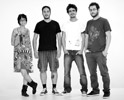 Cia de foto (Brazil, 2003). Photography Co. (Brazil, 2003). Brazilian photography collective whose works employ various visual languages, questioning the context and multiple meanings of the image. Using theoretical and experimental research, they seek to expand the limits of photographic perspectives. They have taken part in several national and international exhibitions, and collaborated in organizing seminars, publications, festivals and curatorships with photography as the central theme. Their work can be viewed at ciadefoto.com
Cia de foto (Brazil, 2003). Photography Co. (Brazil, 2003). Brazilian photography collective whose works employ various visual languages, questioning the context and multiple meanings of the image. Using theoretical and experimental research, they seek to expand the limits of photographic perspectives. They have taken part in several national and international exhibitions, and collaborated in organizing seminars, publications, festivals and curatorships with photography as the central theme. Their work can be viewed at ciadefoto.comOut of all the projects carried out by Cia de Foto, this is undoubtedly the most subjective one, as it shares a space that tests the coexistence of the members, their daily life and also the material that unites them: intimacy and affection. To paraphrase Duchamp, this is a “definitely unfinished” project , with an uncertain beginning point, which starts with time undefined in memory and includes formats as varied as those that can be found when one opens a box full of photographs.
In this manner, and following a request by the curator, Eder Chiodetto, this project was integrated into the Collectors’ club of the MAM (Museu de Arte Moderna) in São Paulo, through a video edit with a soundtrack by DJ Guab. The version presented here became the most famous one.
 Cia de foto (Brazil, 2003). Photography Co. (Brazil, 2003). Brazilian photography collective whose works employ various visual languages, questioning the context and multiple meanings of the image. Using theoretical and experimental research, they seek to expand the limits of photographic perspectives. They have taken part in several national and international exhibitions, and collaborated in organizing seminars, publications, festivals and curatorships with photography as the central theme. Their work can be viewed at ciadefoto.com
Cia de foto (Brazil, 2003). Photography Co. (Brazil, 2003). Brazilian photography collective whose works employ various visual languages, questioning the context and multiple meanings of the image. Using theoretical and experimental research, they seek to expand the limits of photographic perspectives. They have taken part in several national and international exhibitions, and collaborated in organizing seminars, publications, festivals and curatorships with photography as the central theme. Their work can be viewed at ciadefoto.comSvjetlana Tepavcevic
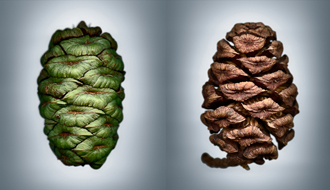

Means of Reproduction is a photography project that explores the transformative power of seeds.
I portray these microcosms as large and mysterious presences, evoking their latent energy and potential to initiate new life through their own transformation. Seeds and the vessels that shield them are essential elements of life and a testament to its enormous vitality and resilience.
The passage of time is a strong element in my images. Seeds themselves are an embodiment of the long and invisible time that continues to shape them and to encapsulate within them the code for new life. Another signifier of passing time, decay, appears frequently and symbolizes memento mori: not only is life fleeting and finite, life and death are two ends of the same continuum.
The selection of images in Means of Reproduction is personal and subjective: I depict only those seeds and seed pods I encounter in ordinary, everyday situations, often while walking. Making these images is an act of contemplation, of discovery and learning, and of love. It brings me closer to nature, whose astonishing designs I now appreciate more than ever.

















 Svjetlana Tepavcevic (Bosnia). Lives and works in Washington D.C. A photographer, she graduated in Art from the University of California and Los Angeles, then received a Masters’ Degree in Art from the Annenberg School of Communication, University of Pennsylvania. She has taken part in numerous exhibitions, both individual and collective, and has received several prizes. Tepavcevic’s work explores her environment, based on detailed and long-term observation and focusing on the relationship with objects. Her work can be viewed at Svjetlana Tepavcevic.
Svjetlana Tepavcevic (Bosnia). Lives and works in Washington D.C. A photographer, she graduated in Art from the University of California and Los Angeles, then received a Masters’ Degree in Art from the Annenberg School of Communication, University of Pennsylvania. She has taken part in numerous exhibitions, both individual and collective, and has received several prizes. Tepavcevic’s work explores her environment, based on detailed and long-term observation and focusing on the relationship with objects. Her work can be viewed at Svjetlana Tepavcevic.

Means of Reproduction is a photography project that explores the transformative power of seeds.
I portray these microcosms as large and mysterious presences, evoking their latent energy and potential to initiate new life through their own transformation. Seeds and the vessels that shield them are essential elements of life and a testament to its enormous vitality and resilience.
The passage of time is a strong element in my images. Seeds themselves are an embodiment of the long and invisible time that continues to shape them and to encapsulate within them the code for new life. Another signifier of passing time, decay, appears frequently and symbolizes memento mori: not only is life fleeting and finite, life and death are two ends of the same continuum.
The selection of images in Means of Reproduction is personal and subjective: I depict only those seeds and seed pods I encounter in ordinary, everyday situations, often while walking. Making these images is an act of contemplation, of discovery and learning, and of love. It brings me closer to nature, whose astonishing designs I now appreciate more than ever.

















 Svjetlana Tepavcevic (Bosnia). Lives and works in Washington D.C. A photographer, she graduated in Art from the University of California and Los Angeles, then received a Masters’ Degree in Art from the Annenberg School of Communication, University of Pennsylvania. She has taken part in numerous exhibitions, both individual and collective, and has received several prizes. Tepavcevic’s work explores her environment, based on detailed and long-term observation and focusing on the relationship with objects. Her work can be viewed at Svjetlana Tepavcevic.
Svjetlana Tepavcevic (Bosnia). Lives and works in Washington D.C. A photographer, she graduated in Art from the University of California and Los Angeles, then received a Masters’ Degree in Art from the Annenberg School of Communication, University of Pennsylvania. She has taken part in numerous exhibitions, both individual and collective, and has received several prizes. Tepavcevic’s work explores her environment, based on detailed and long-term observation and focusing on the relationship with objects. Her work can be viewed at Svjetlana Tepavcevic.


